Drinking Italy part 1 Northern Italy
Posted - May 15 2008
By Daenna Van Mulligen
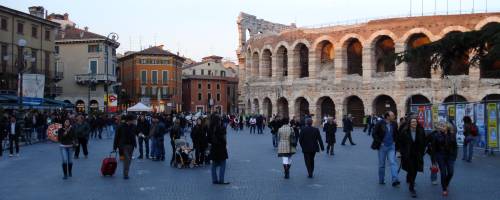
Verona Italy - the Arena
They walk a little slow, they drive a little
fast, they arrive a little late but oh dio mio they make good wine.
Si-si, the Italians.
Tasting my way through countless wines during a recent trip to Italy didn’t tire
me out so much as fire up my engines for more. Part of the beauty of traveling
to Italy is that you’re able to taste so many wines and so many different
varietals (that you’ve never even heard of). But as a journalist it’s also
extremely hard to write about all the wonderful wines you’ve tasted that your
readers cannot. So I’ve rounded up a fine selection – all available locally – to
illustrate what I love about Italian wine.
What do I appreciate the most about Italy? The
simple culture of wine. We carry the weight of virtual hysteria when it comes to
wine in our own culture - are we ordering the right one, will our guests think
we have no taste, will the sommelier shun us if we order that wine, are we
spending enough or too much? Italians drink wine to round out their meal – its
part of everyday life. What a refreshing and natural concept.
I knew I would be staying in and around Verona, so I figured - how much Prosecco
could I consume? I was certain I'd be drinking Prosecco until I exploded –
whether from sheer volume of liquid or from a build-up of tiny spumante bubbles.
As it tuned out I didn’t drink nearly as much as I thought (unless you count the
amount I consumed in the local favorite aperitif, “spritz with Aperol") instead,
with the help of the Vinitaly wine festival, I tasted my way through the
country.
To prevent confusion I’ll take you on a three part liquid tour region by region
– the north part 1, the south part 2 and central Italy part 3.

Northeast – the Veneto
Prosecco is a favoured
white grape here where it’s made into my frothy dream drink. The kingdom where
Prosecco is queen is Valdobbiadene - although Prosecco can be made in other
regions and similar gently sparkling wines are made
from other varietals - including
red grapes.
As a wine, Prosecco
is finally taking off at a slow trot as more of
them are becoming available and accepted locally. My favorites are Cantina
Breganze – their apple-y
Vespaiolo or regular
"Extra Dry" Prosecco will charm you. Newly
arrived on the shelves this month Cantina Breganze has introduced their
Prosecco/Marzimino – pretty in pink and refreshing as heck.
And the
Col de Salici Prosecco de Valdobbiadene in its elegant bottle is harder to
find but is also a delicious option.
Another consumer favourite -
the highly recognizable Mionetto products are readily available and kick in at
about $15-$30. Mionetto’s options are endless, from their
Il Prosecco, sweeter
brunch-perfect Il Moscato,
Sergio MO Extra Dry or the delicious
MO Rose.

But
happily there are many more products than that
including the uber-popular
Valdo
Prosecco Marco Oro
which is suitable, any time of the day.
Canella - a family owned (an extremely
warm and attractive group of siblings) producer makes a beautiful and creamy
Prosecco di Conegliano which is available locally in private wine stores.
But I've never met a summer sipper who hasn't loved the
Canella Bellini in a bottle made with Prosecco and natural white peaches.
It's beautiful peachy colour and low alcohol make it a perfect aperitif or
breakfast wine.
Amarone – the extreme
opposite of the light, low alcohol and refreshing bubbly known as Prosecco would
be the intense, bold and boozy style of Amarone.
Amarone is made by partially
drying the grapes in a method called
made by partially
drying the grapes in a method called
appassimento. But whereas a recioto-style wine (also made by appassimento) is made sweet, Amarone is fermented dry. The dried grapes
produce a glycerin feel to the Amarone wines which are texturally appealing but
also give the perception of fruit sweetness. The grape varieties in Amarone are
primarily Corvina and to a lesser extent Rondinella and Molinara. One of the
most recognizable names is
Masi Agricola which produces a range of dense Amarones including a Classico,
a Costasera and Alighieri in Veneto they have expended to make similar wines in
Argentina using Corvina and Malbec -
Masi Corbec. But as a smaller producer - and therefore harder to find, the
delicious Speri Amarone "Sant Urbano" (about $70) and the Speri
Valpolicella "La Roverina" (about $26) are worth tracking down and can be
found in limited amounts in BC, Alberta, Ontario and Quebec.
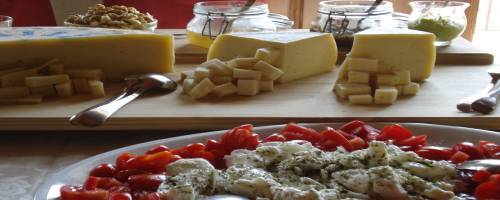
a sampling of local
Montasio and other cheeses, honey and walnuts in Colli Orientali del
Friuli
Extreme Northeast
Friuli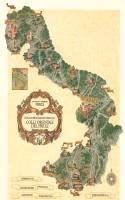
Colli Orientali del Friuli
I spent three days touring
around the small prawn shaped
region of Colli Orientali del Friuli (eastern Friuli) that shares its a border
with Slovenia.
It was a wonderful side-trip filled with warm
hospitality and enthusiasm from the locals who made sure we we enjoyed their wines paired with the regional
favorites; polenta (in many forms) and the wonderful
local cheese called Montasio.
map of Colli Orientali del Friuli
We also stopped at
Midolini - a local producer of
balsamico where we sampled their sweet-unctuous 30year old version and
Domenis
a local grappa distillery where we burned through some of their 40-50 and 60
percent firewater.
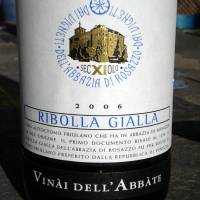
As for the wines…names I’d never heard of appeared in my glass; Schioppettino,
Ribolla Gialla and Pignolo….
Of these three, sadly, I have tasted nothing locally available to share with you
but I was able to track down other well-known regional varietals like Refosco...
The
Livon Refosco dal Peduncolo Rosso has wonderful
rustic aromas - saddle leather, dark cherries, peppery spice,
raisins, violets and coffee grounds notes.
Medium-bodied and smooth...
read review here

In Colli many of the
wineries were very modern, recently built or rebuilt and the quality was
reflected in the wine.
Wineries like Petrucco, Valchiaro, Aquila del Torre, La Sclusa and perhaps my
favorite - Comelli proved to us that tradition and innovation truly do go hand
in hand. The aromatic white Tocai Friulano (soon to be merely Friulano?) and the
simple red Refosco are two local Colli heroes that I enjoyed while there and
with fond memories I tracked down a lovely local option for you. The
Schiopetto Tocai Friulano is golden-hued with clean terroir-driven
minerality, apricots, lemon zest, orange rind and fresh floral notes...
read review here
Ramandolo
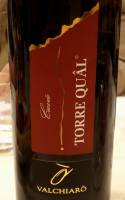
The
tiny 60 hectare appellation of Ramandolo just received
its DOCG zone status in
2001 – one of the latest in Italy to
do so followed last year by the only other DOCG in Colli Orientali del Friuli (also for a sweet recioto wine) - Picolit.
During a brief visit in Ramandolo we lunched in a stunning hilltop Villa and drank the
sweet, late harvested then dried grape wines of Toblâr, Maurizio Zaccomer and
Marinig.
These sweet, golden wines
are best served with
hors d’oeuvres – blue cheese, Parmesan chunks, the local Montasio cheese or pate, smoked fish, salumi with figs and local honey with
hazelnuts.
Although Ramandolo is a region, it is also the nickname
for the Verduzzo Gialla (yellow Verduzzo) grape that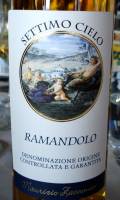
the wines of Ramandolo are made from.
pictures along right are all
wines from Colli Orientali del Friuli
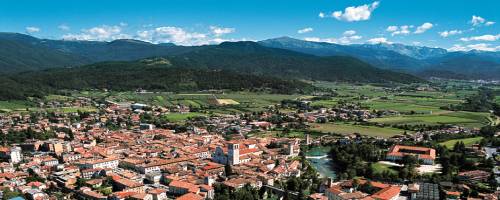
the city of Cividale in Friuli

North-Northeast
Trentino - Alto Adige
A beautiful, mountainous region that sits above the Veneto and shares its
northern border with Austria - a location which is
mirrored in its architecture and in the freshness of its
cooler-climate wines.
During the Vinitaly wine festival I tasted the wines from Mezzacorona. Some of
my favourite wines from this producer that are available across Canada are the
red
Teroldego Rotaliano Riserva the
Pinot Grigio Riserva and the sparkling, fruity/floral and and creamy
Teroldego Rotaliano Riserva (private wine stores - about $20+).
North Central

the tasting bar at Antica Fratta in the Lombardy Pavilion
straight out of Wallpaper magazine...
Lombardy
Having only visited its main city of Milan many years ago, I look forward to visiting Lombardy
again, this time as a wine region. Not
only to gorge myself on the local Taleggio cheese but to drink the “Champagne of
Italy” - Franciacorta.
The region “Franciacorta” is made up of about 200 growers
(still and sparkling wines) and about 1500 hectares of planted
vineyard – it is
located east of Milan and sits just above the
city of Brescia. Franciacorta
sparkling wines received their
DOCG status in 1995 and the guidelines for being
considered a
 Franciacorta DOCG are strict. The sparkling wines must be made in
the traditional method using the grape varietals of Pinot Noir, Pinot Blanc and
Chardonnay. And similar to Champagne, Franciacorta has; Vintage, Brut, Demi-Sec,
Sec and Rosé, Franciacorta has those plus, Satén - an extremely appealing name
for a creamy blanc de blancs. During Vinitaly, I spent a couple of hours one day
losing myself in these sparkling wines – too few of which are found here
in Canada. The most beautifully labeled were those from Antica Fratta. In fact
they were so beautifully designed they deserve to be in Wallpaper Magazine. We
also tasted those from Ferghettina, La Gallinaccia, Mirabella and many more.
Franciacorta DOCG are strict. The sparkling wines must be made in
the traditional method using the grape varietals of Pinot Noir, Pinot Blanc and
Chardonnay. And similar to Champagne, Franciacorta has; Vintage, Brut, Demi-Sec,
Sec and Rosé, Franciacorta has those plus, Satén - an extremely appealing name
for a creamy blanc de blancs. During Vinitaly, I spent a couple of hours one day
losing myself in these sparkling wines – too few of which are found here
in Canada. The most beautifully labeled were those from Antica Fratta. In fact
they were so beautifully designed they deserve to be in Wallpaper Magazine. We
also tasted those from Ferghettina, La Gallinaccia, Mirabella and many more.
Locally – imported by Empson Canada is Bellavista (see right) - your best bet
the Cuvee Brut DOCG, found in private wine stores is fresh, elegant and creamy
and costs about $50.
And on the southern slopes of the Retiche Alps against the Swiss
border are the terraced vineyards of Valtellina.

These south facing slopes rise to 800m
above sea level and
are home to the grapes in the historical
Cantina Balgera wines.
I met Paolo Balgera early on during my trip to Italy - he was also a judge for
the
Vinitaly International Wine Competition. Paolo, like his father, followed in
the footsteps of his great, great, great grandfather and is now the eonologist
continuing the tradition of making wines at Cantina Balgera.
Unfortunately none of his wines are available in Canada, but I was able to bring
home one bottle of his delicious Balgera Valtellina Sforatzo DOC wine
made from Nebbiolo grapes that are air dried on special racks in the
appassimento style like Amarone. The literal translation for Sforzato is
- to force, in this case it means forced to dry
producing an intense and powerful wine with sweet, rich fruit and dried fruit
aromas, with flavours of peppery spice, licorice and sweet raisins.
Northwest
Piedmont
Here lays the king – Barolo.
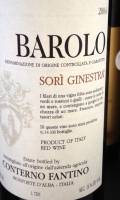
Made from Nebbiolo these wines are sought world-wide by lovers, collectors and
investors. The similarities drawn to the velvety and somewhat ethereal Pinot
Noir are not unfounded in my books. Perhaps that is why I crave them both and
why I'm so disappointed when they don’t live up to my expectations.
But there
are producers that always seem to – despite the vintages - make great wine. Many
of these producers are well known
and available in Canada, although rarely in large quantities.
But with over 50
other DOCs and DOCGs in Piedmont you mustn’t forget Barbera. Specifically those
wines made from the Barbera grape in the DOCGs of Asti, Alba and Monferrato.
Or Dolcetto, from a number of pockets of vineyards and sub-regions (including Asti
and Alba) around Piedmont.
Asti is both a commune and a town in Piedmont about
55km east of Turin.
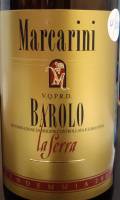
Of course internationally Asti is more recognized for its sweet,
sparkling wines - Asti Spumante DOCG and Moscato d’Asti DOCG which are good but
far different from the reds.
Alba sits south of
Asti but above Barolo.
Some favourite wines that I tasted from Piedmont during Vinitaly were: (all are
available in limited quantities in Canada)
Bongiovanni Barolo "Pernanno" (2000 vintage about $90 in BC), the
Conterno Fantino Barolo "Sori Ginestra" (2003 about $110 in BC), the
Einaudi Barolo "Costa Grimaldi" (2004 about $100 in BC but a small
re-release of the 1999 vintage are coming soon), the Marcarini Barbera
d'Alba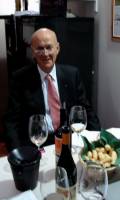 "Ciabot Camerano" (2006 is about $25. in BC) and the Marcarini Barolo "La
Serra" and the Barolo"Brunate" (both 2004 vintages, each about $70 in
BC).
"Ciabot Camerano" (2006 is about $25. in BC) and the Marcarini Barolo "La
Serra" and the Barolo"Brunate" (both 2004 vintages, each about $70 in
BC).
Michele
Chiarlo at Vinitaly
While at Vinitaly I was reacquainted with the gentleman known as Michele
Chiarlo whose lovely wines are also available here in Canada. In February
Michele was in Vancouver where he held a small tasting of his wines...read
article here

But one wine was new to me - his
Montald Albarossa
from Monferato, a new cross between Nebbiolo and Barbera.
It was a lovely wine with grapey aromas, earth, coffee and chocolate with sweet
fruit and a lush palate. The vines for the "new" Albarossa are now 10 years old
and I look forward to
tasting this wine again when the vines are 20 years old.
(Not available in Canada yet.)
Michele Chiarlo Montald Albarossa

And, although I met Pierluigi Chiarle from Bava,
I was never able to taste his wines during the
wine festival. It was only when I returned to Vancouver
that I
tasted the
Bava "Libera" Barbera d'Asti -
a ruby-hued Barbera hinting at brick with sweet,
earthy cherry aromas, dark floral and dried
fruit notes with a touch of orange peel...
read review here
But we can't forget the white wines can we.
One of my favorite white wines from Piedmont
is from the internationally renowned Castello Banfi from Tuscany,

although this refreshing white is made under Banfi's
sister winery Vigne Regali.
The
"Principessa Gavia" - is a classic Italian DOCG white made from 100%
Cortese that's a wonderful food wine. Clean and fresh showing soft white fruit,
citrus blossoms and honeyed aromas with almond skin...
Read the review
Coming Next: Drinking Italy part 2




 made by partially
drying the grapes in a method called
made by partially
drying the grapes in a method called 








 Franciacorta DOCG are strict. The sparkling wines must be made in
the traditional method using the grape varietals of Pinot Noir, Pinot Blanc and
Chardonnay. And similar to Champagne, Franciacorta has; Vintage, Brut, Demi-Sec,
Sec and Rosé, Franciacorta has those plus, Satén - an extremely appealing name
for a creamy blanc de blancs. During Vinitaly, I spent a couple of hours one day
losing myself in these sparkling wines – too few of which are found here
in Canada. The most beautifully labeled were those from Antica Fratta. In fact
they were so beautifully designed they deserve to be in Wallpaper Magazine. We
also tasted those from Ferghettina, La Gallinaccia, Mirabella and many more.
Franciacorta DOCG are strict. The sparkling wines must be made in
the traditional method using the grape varietals of Pinot Noir, Pinot Blanc and
Chardonnay. And similar to Champagne, Franciacorta has; Vintage, Brut, Demi-Sec,
Sec and Rosé, Franciacorta has those plus, Satén - an extremely appealing name
for a creamy blanc de blancs. During Vinitaly, I spent a couple of hours one day
losing myself in these sparkling wines – too few of which are found here
in Canada. The most beautifully labeled were those from Antica Fratta. In fact
they were so beautifully designed they deserve to be in Wallpaper Magazine. We
also tasted those from Ferghettina, La Gallinaccia, Mirabella and many more.



 "Ciabot Camerano" (2006 is about $25. in BC) and the Marcarini Barolo "La
Serra" and the Barolo"Brunate" (both 2004 vintages, each about $70 in
BC).
"Ciabot Camerano" (2006 is about $25. in BC) and the Marcarini Barolo "La
Serra" and the Barolo"Brunate" (both 2004 vintages, each about $70 in
BC).

